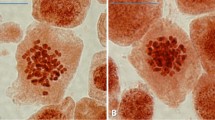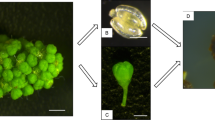Abstract
Ethiopian mustard (Brassica carinata Braun) is a potential oil crop for the Mediterranean area. The objective of this study was to develop an efficient system of mutagenesis using ultraviolet (UV) light irradiation of isolated microspores from Brassica carinata. From the survival curve based on embryo yield after irradiation of the microspores with UV light, the LD50 was estimated to be an exposure of 8 min. Total content of glucosinolates and fatty acid composition were analysed in the seeds of the doubled haploid homozygous plants with the purpose of selecting lines with modified glucosinolate and erucic acid contents. Three groups of doubled haploid lines exhibiting low and high glucosinolate contents, and high erucic acid content have been identified from a population of 270 doubled haploid lines. In eight lines, the content of glucosinolates was reduced from an average of 80.6 μmol g-1 seed to 37.5 μmol g-1 seed, whereas in four lines, the content of glucosinolates was increased up to 99.2 μmol g-1 seed. In six additional lines, the content of erucic acid was increased from 42.8% in the nontreated lines to 49.5% of the totalfatty acid composition in some of the mutant lines. All lines showed stablelevels of erucic acid in two generations, the M2 and M3.
Similar content being viewed by others
References
Ahmad, I., J.P. Day, M.V. Macdonald & D.S. Ingram, 1991. Haploid culture and UV mutagenesis in rapid-cycling Brassica napus for the generation of resistance to chlorsulfuron and Alternaria brassicicola. Ann Botany 67: 521-525.
Barro, F. & A. Martín, 1999. Response of different genotypes of Brassica carinata to microspore culture. Plant Breed 118: 79-81.
Fourmann, M., P. Barret, M. Renard, G. Pelletier, R. Delourme & D. Brunel, 1998. The 2 genes homologous to arabidopsis Fae1 co-segregate with the 2 loci governing erucic-acid content in Brassica-napus. Theor Appl Genet 96: 852-858.
Friedt, W. & W. Lühs, 1998. Recent developments and perspectives of industrial rapeseed breeding. Fett Lipid 100: 219-226.
Gamborg, O.L., R.A. Miller & K. Ojima, 1968. Nutrients requirements of suspension cultures of soybean root cells. Exp Cell Res 50: 151-158.
Garces, R. & M. Mancha, 1993. One-step lipid extraction and fatty acid methyl esters preparation from fresh plant tissue. Anal Biochem 211: 139-143.
Getinet, A., G. Rakow, J.P. Raney & R.K. Downey, 1996. Agronomic performance and seed quality of Ethiopian mustard in Saskatchewan. Can J Plant Sci 76: 387-392.
Huang, B., 1992. Genetic manipulation of microspores and microspore-derived embryos. In Vitro Cell Dev Biol 28: 53-58.
Lühs, W. & W. Friedt, 1995. Breeding of high erucic-acid rapeseed by means of Brassica napus resynthesis. In: Rapeseed-Today and Tomorrow, Proc 9th Intl Rapeseed Congr. Dorchester, UK, pp. 449-451.
MacDonald, M.V., M.A. Hadwiger, F.N. Aslam & D.S. Ingram, 1988. The enhancement of anther culture efficiency in Brassica napus ssp. oleifera Metzg. (Sinsk) using low doses of gamma irradiation. New Phytol 110: 101-107.
Maluszynski, M., B.S. Ahloowalia & B. Sigurbjörnsson, 1995. Application of in vitro mutation techniques for crop improvement. Euphytica 85: 303-315.
Menten, J.O.M., A. Tulman Neto, A. Ande, J.T. Yorinori, S.S. Costa, J.A. Deslandes & J.C.O. Silverio, 1984. Induced mutations for improving disease resistance in soybean, Glycine max L. In: Induced Mutations for Crop Improvement in Latin America, IAEA, Vienna, pp, 173-189.
Mnzava, N.A. & K. Olsson, 1990. Studies on tropical vegetables. Part 1. Seed amino, fatty acid and glucosinolate profile of Ethiopian mustards (Brassica carinata Braun). Food Chem 35: 229-235.
Nitsch, C. & J.P. Nitsch, 1967. The induction of flowering in vitro in stem segments of Plumbago indica L. I. The production of vegetative buds. Planta (Berl.) 72: 355-370.
Pecham, P.M. & W.A. Keller, 1989. Induction of microspore embryogenesis in Brassica napus L. by gamma irradiation and ethanol stress. In Vitro Cell Dev Biol 25: 1073-1075.
Shahidi, F., 1990. North American production of canola. In: F. Shahidi (Ed.), Canola and Rapeseed: Production, Chemistry, Nutrition and Processing Technology, pp. 15-23. Van Nostrand Reinhold, New York.
Sontag, N.O.V., 1991. Erucic, behenic: Feedstocks of the 21st century. Inform 2: 449-463.
Taylor, D.C., D.L. Barton, E.M. Giblin, S.L. Mackenzie, C.G.J. Van den Berg & P.B.E. McVetty, 1995. Microsomal Lysophosphatidic acid aciltransferase from a Brassica oleracea cultivar incorporates erucic acid into the sn-2 position of seed triacylglycerols. Plant Physiol 109: 409-420.
Thies, W., 1982. Complex-formation between glucosinolates and tetrachloropalladate (II) and its utilization in plant breeding. Fette Seifen Anstrichmittel 84: 338-342.
Tonnemaker, K.A., D.L. Auld, D.C. Thill, C.A. Mallory-Smith & D.A. Erickson, 1992. Development of sulfonylurea-resistent rapeseed using chemical mutagenesis. Crop Sci 32: 1387-1391.
Velasco, L., J.M. Fernández-Martínez & A. De Haro, 1998. Increasing erucic acid content in Ethiopian mustard through mutation breeding. Plant Breed 117: 85-87.
Wong, R.S.C. & E. Swanson, 1991. Genetic modification of canola oil: high oleic acid canola. In: C. Haberstroh & C.F. Morris (Eds.), Fat and Cholesterol Reduced Foods: Technologies and Strategies, pp. 153-164. Portfolio Publ. Co. The Woodlans, TX.
Zhao, J.I., D.H. Simmonds & W. Newcomb, 1996. Induction of embryogenesis with colchicine instead of heat in microspores of Brassica napus L. cv. Topas. Planta 198: 433-439.
Author information
Authors and Affiliations
Rights and permissions
About this article
Cite this article
Barro, F., Fernández-Escobar, J., De la Vega, M. et al. Modification of glucosinolate and erucic acid contents in doubled haploid lines of Brassica carinata by UV treatment of isolated microspores. Euphytica 129, 1–6 (2003). https://doi.org/10.1023/A:1021578318098
Issue Date:
DOI: https://doi.org/10.1023/A:1021578318098




